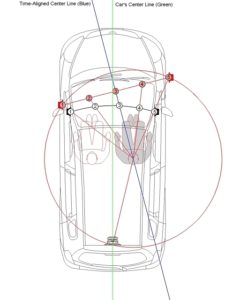My friend has told me that he has tremendous sound installment and a superb tuning with a lot of tweak and diy passive x’over circuits on his brand new impreza. Because he keeps bragging on the sound quality reproduction with the correct time alignment software and calculation, I can’t help myself want to listen and “taste” his audio system. We met at some restaurant and after a rush late dinner we head of to his home. After some whatever chit chat conversation with his wife for polite manner then we go to his garrage and finally listen to his audio with Hotel California as a prelude. I’m not sure wheater this system is misallignment or my ears become disintegrated … I don’t feel any staging nor an stage image at all. The tonal balance is quite good though but the tweeter and the midrange was not give the exact blend. The subsonic from low bass also feel on the center of the cabin and not well blend mix with the midrange coming from the dashboard. I keep quiet and keep changing the source and listen … and listen … until I jump to conclusion … this is not the system I want to listen. Not totally waisting my time because the sound quality is very good reproduce by his microprecission speakers, but this is certain misallignment problems.
Bassicaly the system is a tri-amp system with Genesis 5 channel poweramps, CDA-9887 as a head unit, PXA H701 with RUX C701 as the controller and ended on the three ways micro precission speakers and Etude 10″ subs on the trunk. Begin to digging around with some compelling dialog at how he set the time correction calculation on the PXA processor then I began to understand that he does not really quite understood what time correction is and always confusing how to determine the farthest speakers and set up the initial value for the delay time.
I want to share from my experience how to set the initial value for the time correction delay :
- Measure distance of all speakers to your listening position. You could use measuring tape for this purpose for easy bending within the cabin if you can’t measure in straight line and try to be precise into millimeter and adjust the listening seat to your listening postion before doing any measurement.
- Pick the furthest speaker. This will be your reference point. If you were not using rear speaker the furthest speaker is usually the subwoofer.
- Take the difference of each speaker from the furthest speaker.
The furthest speaker (usually subwoofer) will be 0.00ms on the t/a, so basically you do no time correction for the furthest speaker. The closest speaker to you should have the most t/a since that’s the largest difference.
I know, some references said that this is based on temperature since speed of sound is based on temperature, fyi. But, just assume some temperature for the sake of measurements.
For example, the subwoofer distance is 168cm and is the furthest speaker. The following is from an excel sheet I made. 2nd number is distance in centimeters, and 3rd number is time correction in milliseconds (ms).
Subwoofer: 167.5cm
Drivers Tweeter: 88.9cm 2.295628013
Passengers Tweeter: 124.5cm 1.258892782
Drivers Midrange: 95.2cm 2.110496722
Passengers Midrange: 129.5cm 1.110787748
Drivers Midbass: 104.7cm 1.832799785
Passenger’s Midbass: 139.7cm 0.814577682
So, you see that the driver’s side tweeter (which is the closest speaker to you) has the most t/a @ 2.29ms. The subwoofer has 0 t/a.
One thing to keep in mind is reflection. If you have a speaker firing at the windshield you’ll want to add some extra distance to account for that the best you can. Also, the excel sheet I use is just to give you an idea of where to start. You should play with the t/a a bit and listen to what you think sounds the best.
Also, honestly, I actually added about 8ms to every t/a value I calculated so that the sub has plenty of time to get “up front” and doesn’t sound like it’s coming from behind as much. This is to compensate that the time correction cannot be negative, I still have space to tweak a little 🙂
Have a nice tuning your audio system 🙂



